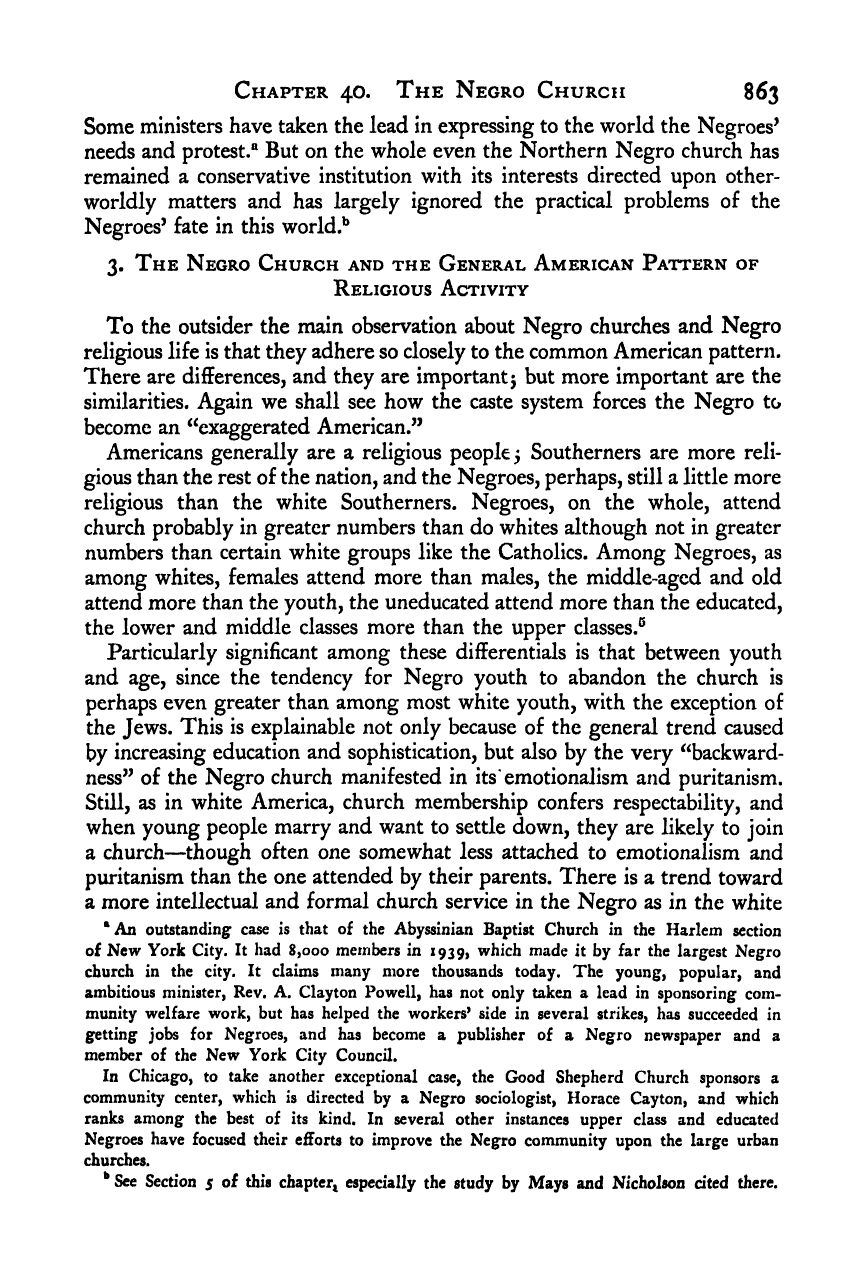Note: Gunnar Myrdal died in 1987, less than 70 years ago. Therefore, this work is protected by copyright, restricting your legal rights to reproduce it. However, you are welcome to view it on screen, as you do now. Read more about copyright.
Full resolution (TIFF) - On this page / på denna sida - IX. Leadership and Concerted Action - 40. The Negro Church - 2. Some Historical Notes - 3. The Negro Church and the General American Pattern of Religious Activity

<< prev. page << föreg. sida << >> nästa sida >> next page >>
Below is the raw OCR text
from the above scanned image.
Do you see an error? Proofread the page now!
Här nedan syns maskintolkade texten från faksimilbilden ovan.
Ser du något fel? Korrekturläs sidan nu!
This page has never been proofread. / Denna sida har aldrig korrekturlästs.
Chapter 40. The Negro Church 863
Some ministers have taken the lead in expressing to the world the Negroes^
needs and protest.® But on the whole even the Northern Negro church has
remained a conservative institution with its interests directed upon other-
worldly matters and has largely ignored the practical problems of the
Negroes’ fate in this world.’*
3. The Negro Church and the General American Pattern of
Religious Activity
To the outsider the main observation about Negro churches and Negro
religious life is that they adhere so closely to the common American pattern.
There are differences, and they are important j
but more important are the
similarities. Again we shall see how the caste system forces the Negro to
become an ^^exaggerated American.”
Americans generally are a religious people 5 Southerners are more reli-
gious than the rest of the nation, and the Negroes, perhaps, still a little more
religious than the white Southerners. Negroes, on the whole, attend
church probably in greater numbers than do whites although not in greater
numbers than certain white groups like the Catholics. Among Negroes, as
among whites, females attend more than males, the middle-aged and old
attend more than the youth, the uneducated attend more than the educated,
the lower and middle classes more than the upper classes.®
Particularly significant among these differentials is that between youth
and age, since the tendency for Negro youth to abandon the church is
perhaps even greater than among most white youth, with the exception of
the Jews. This is explainable not only because of the general trend caused
by increasing education and sophistication, but also by the very ^‘backward-
ness” of the Negro church manifested in its’ emotionalism and puritanism.
Still, as in white America, church membership confers respectability, and
when young people marry and want to settle down, they are likely to join
a church—though often one somewhat less attached to emotionalism and
puritanism than the one attended by their parents. There is a trend toward
a more intellectual and formal church service in the Negro as in the white
*An outstanding case is that of the Abyssinian Baptist Church in the Harlem section
of New York City. It had 8,000 members in 1939, which made it by far the largest Negro
church in the city. It claims many more thousands today. The young, popular, and
ambitious minister. Rev. A. Clayton Powell, has not only taken a lead in sponsoring com-
munity welfare work, but has helped the workers’ side in several strikes, has succeeded in
getting jobs for Negroes, and has become a publisher of a Negro newspaper and a
member of the New York City Council.
In Chicago, to take another exceptional case, the Good Shepherd Church sponsors a
community center, which is directed by a Negro sociologist, Horace Cayton, and which
ranks among the best of its kind. In several other instances upper class and educated
Negroes have focused their exports to improve the Negro community upon the large urban
churches.
**
See Section 5 of this chapterj especially the study by Mays and Nicholson dted there.
<< prev. page << föreg. sida << >> nästa sida >> next page >>